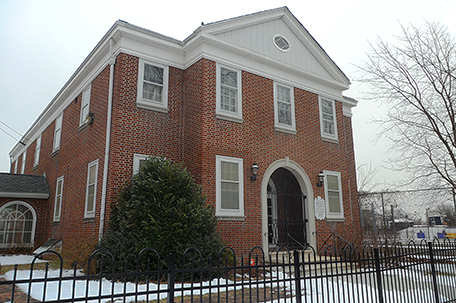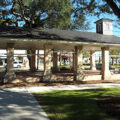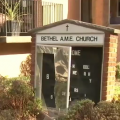
ABOVE PHOTO: Camden County Historical Society
By Renée S. Gordon
“In this hallowed ground lie the remains of people of African descent
who were servants and slaves during the 1700s and 1800s.
They are unknown to us, but precious to God.”
–2011 Christ the King Episcopal Church
Philadelphians tend to think of Southern New Jersey as an extension of Philadelphia and Northern New Jersey as a suburb of New York. People fail to remember that NJ was one of the 13 original colonies and it was the 3 third state to ratify the Constitution. At the time those events occurred the Leni-Lenape, “original people,” had occupied the land for more than 6,000-years and it was they who greeted Giovanni da Verrazano in the 1520s when he sailed into Newark Bay.
The colony that would become New Jersey was initially a part of the 1621 Dutch settlement known as New Netherlands that encompassed what are now the Mid-Atlantic States. Slavery was introduced into the settlement in 1627 when a ship bearing 11 black men landed. In 1664 the British took control from the Dutch and a colony was founded by an English proprietary governed by Berkeley and Carteret in the New Jersey area that same year. They legalized slavery because their goal was to encourage colonists to engage in farming and business and as an incentive they offered 60-acres of land to each settler for each slave they brought into the colony.
Thirty-eight years later New Jersey became a crown colony, meaning the British government oversaw legislation, and appointed a governor. Queen Anne charged the governor with helping the Royal African Company in order to maintain an ample, affordable supply of Negroes. Slaves were necessary and free blacks were not and legislation was enacted that forbade freedmen from land ownership in New Jersey.
The trade was lucrative and the majority of the slave ships docked in Perth Amboy, the heart of the colony’s slave trade. In the years prior to the Civil War all but one family in Perth Amboy owned slaves. As the numbers increased harsh slave laws were authorized and a special court was set up to deal with slave offenses. The punishments were severe and included flogging and burning at the stake. By the mid-1700s the number of slaves was approximately 12 percent of the population. In 1786 a ban was placed on the importation of slaves.
“An Act for the Gradual Abolition of Slavery” was passed by the state in 1846. The act freed all children born after its passage. Interestingly, freed slave children could be given to the care of the state’s welfare system at a monthly cost to the state of $3. The former owner could then agree to house the slave child and receive the stipend. At one point this system was 40 percent of New Jersey’s budget. By the 1830s, NJ contained more than 2/3 of all the slaves that remained in the Northern states. The state, in 1846, was the last in the North to formally abolish slavery. The 1860 census notes 18 slaves remained in the state.
In the years prior to the Civil War the Eastern corridor was a highway to freedom. Underground Railroad (UGRR) routes linked the southern states with stations in Philadelphia, New York and then on to Canada and New Jersey was a vital link in this chain. No other northern state had more free black communities that provided sanctuary, the majority located in the southern area, and included Fettersville, Jericho, Lawnside, Sadlers Wood, Springside and Timbuctoo.
At least three major routes crossed New Jersey and it is estimated that several thousand freedom seekers escaped to New York and Canada using those routes. The terminus of the Jersey stations was in the same area where the first slaves entered the state in the 1600s. Two of the most famous individuals to work with the UGRR are also connected with New Jersey. Harriet Tubman worked in Cape May from 1842-52 from 1842-52 as a maid between trips to liberate slaves in order to help finance her journeys. William Still, who was born in the state, lived in Lawnside.
Relevant sites are located throughout the state from Camden to Jersey City. Visitors have an opportunity to explore as a series of day trips from Philadelphia or spend a weekend traveling the state and lodging in a central location. You must call for times because many of the sites are open during limited hours in the winter. www.visitnj.org
Perth Amboy, NJ’s earliest ocean port, is 72-miles from Philadelphia and was once one of two colonial capitols from 1686-1776. The city was originally known as “Ompoge,” meaning “the point,” then “Amboyle,” but by the time of its incorporation it was renamed using two words, one Native American and one after the Scottish Earl of Perth. It remains the nation’s only city incorporated twice, in 1718 and again in 1784. The city has numerous sites that are significant in the nation’s history.
The only intact Royal Governor’s Mansion, the Proprietary House, was constructed in 1762. William Franklin, son of Benjamin, was the final royal governor to reside in the house. He served from1763-1776 at which time he was removed by the Continental Congress and ultimately exiled to England where he died.
Slaves who entered through the city’s port were kept in slave pens at Water and Market Streets.
A number of zealous abolitionists resided in the city. One, Rebecca Spring, went to Virginia to support John Brown and attend to their wounds upon hearing of their arrest after Harper’s Ferry. While there she promised to take the bodies of Brown and two black men, Absolom Haslett and Aaron Dwight to be buried in a free state. The government refused to release Brown’s body but the bodies of Haslett and Dwight were interred in Perth Amboy on her estate until 1899 when they were reburied in North Elba.
Marcus and Rebecca Spring founded the Raritan Bay Union, a society of liberal intellectuals, on their land. Noted abolitionist sisters, Sarah and Angelina Grimke, taught at the integrated school there and Amos Alcott and Henry David Thoreau visited.
St. Peter’s Church was established in 1698 and is the oldest Episcopal Parish in NJ. The current church is the second at the location and was erected in 1850. A highlight of a tour of the interior is the silver communion service gifted to the church by Queen Anne. The graves in the cemetery include those of freedmen and slaves and that of Thomas Mundy Peterson, the first African American voter under the fifth Amendment. www.stpetersepiscopal.com
The Morris Museum in Morristown, NJ was established 101-years ago. The museum features art, general history, natural history and science with emphasis on the African culture of New Guinea. www.morristourism.org
The Grimes Homestead, constructed in the 1700s, functioned as an UGRR station. Quaker Dr. John Grimes, the most ardent member of the family, edited the New Jersey Freeman, was often mobbed and was even arrested for providing haven for a runaway. The Freeman was the first abolitionist newspaper in the state and was published from 1844-50. The Mountain Lakes home is privately owned. www.nps.gov/nr/travel/underground/nj1.htm
Located in Woolwich Township is the extremely significant Mount Zion African Methodist Episcopal Church. Pompey Lewis and Jubilee Sharper established the church in 1799. In 1834, the church was constructed and was an UGRR station whose primary purpose was to shelter, feed, supply and provide information to escapees. The church had a hidden crawlspace that was accessed through the floor of the vestibule. It was listed on the NRHP in 2001. www.nps.gov/nr/travel/underground/nj4
Lawnside is one of the sole remaining self-governing African American cities in the nation and was the first in the North. The town was created in the 1700s when a Haddonfield Quaker, Ralph Smith, purchased tract of land and sold smaller plots to black people, both free and enslaved. As word of the enclave, known as Free Haven, spread it became a harbor for freedom seekers and a transit point on the UGRR. Lawnside was home to William Still who kept copious notes on the fugitives that passed through the area. His book, “The Underground Railroad,” is still considered one of the most valuable resources on the inner workings of the UGRR. Close to 50 men volunteered to serve in 22nd US Colored Troops in the Civil War. The town was not officially named Lawnside until 1907.
Mount Peace Cemetery was listed on the National Register of Historic Places (NRHP) in 2009. The 18-acre burial ground is the location of at least 77 Civil War veterans, one of which is John Lawson, winner of the Congressional Medal of Honor for service aboard the USS Hartford in 1864. The cemetery was founded because many of the people could not be buried anywhere else because of segregation.
The 1845, two story, Peter Mott House was home to a free African American minister who was also a stationmaster and conductor on the UGRR. He purchased the home for $100 in 1844 and lived there until his death in 1881. Tours of the interior highlight original architectural elements such as the plasterwork, the staircase and a corner cabinet. Mott is buried in the cemetery of Mount Pisgah African Methodist Episcopal Church. www.petermotthouse.org
Just across the bridge is Camden, NJ, one of the state’s most historic cities. The Port of Camden was an important dock for slave ships traveling from Africa. Many of the traders and the ferry owners were Quakers who grew rich off the profits. Beginning in 1688 the establishment of the ferry system caused people to settle in the area. Slave ships off-loaded in Camden as opposed to Philadelphia because the taxes were not as steep in NJ.
The Cooper family was heavily involved. They owned Cooper’s Ferry, where slave sales were held, now the site of Dr. Ulysses S. Wiggins Waterfront Park, until 1765. Slaves were held on Petty’s Island, the third largest in the Delaware River, also partially owned by the Coopers. One of the reminders of this era, the Benjamin Cooper House, is still at Point and Erie Streets but was heavily damaged by fire in 2012. The 1700’s stone Dutch colonial was a ferry house and served as British headquarters during the American Revolution.
The Camden County Historical Society is the place to go to learn regional history including that of African and Native Americans, RCA and Campbell Soup. The society complex also consists of a research library and Pomona Hall. www.cchsnj.com
No seeker of the “real” story of NJ should miss the 1726 Pomona Hall, plantation home of William Cooper Jr. During his lifetime he owned one slave but slave laborers probably built the residence. When Marmaduke Cooper gained ownership the house doubled in size from a simple two rooms over two rooms. Marmaduke was the owner of 14 slaves and in 1780 the Haddonfield Quakers expelled him for failure to free.
Tours of Pomona’s interior are filled with singular features including original floorboards and woodwork and a 1st floor prayer closet, one of only two remaining. The stair leading to the second floor is original. One of the five rooms on this level is outfitted to show the slave experience at the house. The room is furnished according to an inventory in Hannah Dent Cooper’s will. Also on this level there is a museum that interprets the UGRR and slavery in Camden County.
Fettersville was established in 1833 as a 22-sq. block free black community in Camden. Richard Fetters owned the land and sold it in parcels at affordable rates.
In 1832 a Rev. Brown from South Carolina founded Macedonia AME Church. The church, the oldest black institution in Camden, was completed in 1838. In the 1840s, Rev. Thomas Clement Oliver, possibly NJ’s most famous UGRR operative was pastor. The church was the state’s southernmost station on the UGRR route. In 1847 a wagon bearing a captured fugitive passed the church on its way to the ferry. As the wagon passed the captive raised a hue and cry inciting the congregation to pour into the street and waylay the wagon. Eventually the slave catchers released the man and fled, exchanging their prisoner for their personal safety.
New Jersey formally abolished slavery in 1846 and 161-years later it became the first state in the north to formally apologize. The apology can be read online. www.i.a.cnn.net/cnn/2008/images/07/270_I1.pdf
Travel enlightens you.
I wish you smooth travels!
TRAVEL TIPS:
The National Museum of American Jewish History’s exhibit, “Chasing Dreams: Baseball and Becoming American,” is on view from March 13 to October 26, 2014. The exhibit will explore how American Jews and other minorities impacted the game of baseball and the American cultural. More than 130 artifacts have been culled from the museum’s collection, and public and private collectors and will include uniforms, memorabilia, films, photographs and original baseball cards. www.nmajh.org
A Slice of Brooklyn Bus Tours embark from Manhattan and take visitors on visits to of the best of Brooklyn in the form of tours of unique communities, historic sites, movie locations and Brooklyn’s best eateries. The guided tour of the best pizzerias has been voted the #1 tour in the borough and the entire collection has been featured on the Today Show, the Food Network, the Travel Channel, the Rachael Ray Show, Martha Stewart Living and numerous guides. Reservations are required and can be made online. www.asliceofbrooklyn.com
St. Maarten’s 45th Annual Carnival celebration kicks off on April 21st and runs through May 5th. There are a host of cultural activities that visitors can get swept up into. St. Maarten is the only island in the world with dual celebrations, one on the French side and another on the Dutch side of the island. Full details can be found online.
www.vacationstmaarten.com
















Leave a Comment